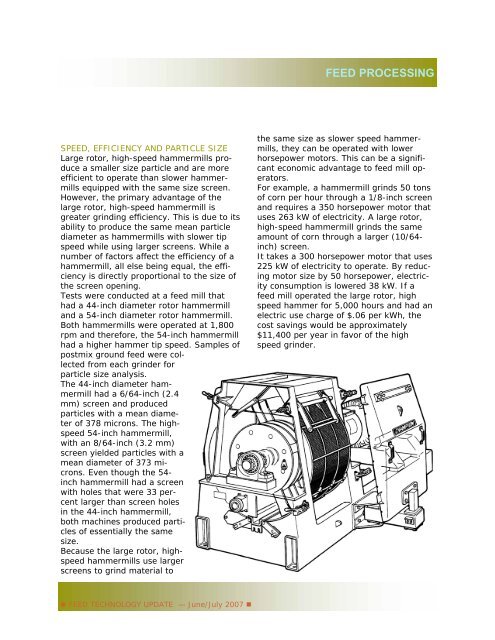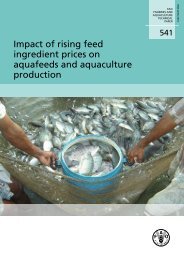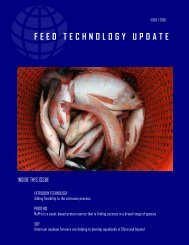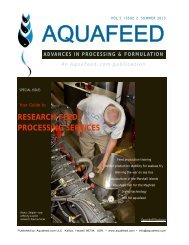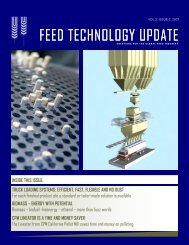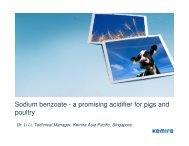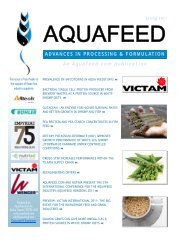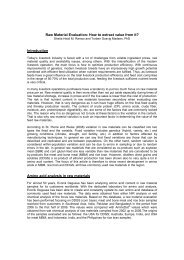feed technology upda feed technology updatete - AquaFeed.com
feed technology upda feed technology updatete - AquaFeed.com
feed technology upda feed technology updatete - AquaFeed.com
Create successful ePaper yourself
Turn your PDF publications into a flip-book with our unique Google optimized e-Paper software.
FEED PROCESSING<br />
SPEED, EFFICIENCY AND PARTICLE SIZE<br />
Large rotor, high-speed hammermills produce<br />
a smaller size particle and are more<br />
efficient to operate than slower hammermills<br />
equipped with the same size screen.<br />
However, the primary advantage of the<br />
large rotor, high-speed hammermill is<br />
greater grinding efficiency. This is due to its<br />
ability to produce the same mean particle<br />
diameter as hammermills with slower tip<br />
speed while using larger screens. While a<br />
number of factors affect the efficiency of a<br />
hammermill, all else being equal, the efficiency<br />
is directly proportional to the size of<br />
the screen opening.<br />
Tests were conducted at a <strong>feed</strong> mill that<br />
had a 44-inch diameter rotor hammermill<br />
and a 54-inch diameter rotor hammermill.<br />
Both hammermills were operated at 1,800<br />
rpm and therefore, the 54-inch hammermill<br />
had a higher hammer tip speed. Samples of<br />
postmix ground <strong>feed</strong> were collected<br />
from each grinder for<br />
particle size analysis.<br />
The 44-inch diameter hammermill<br />
had a 6/64-inch (2.4<br />
mm) screen and produced<br />
particles with a mean diameter<br />
of 378 microns. The highspeed<br />
54-inch hammermill,<br />
with an 8/64-inch (3.2 mm)<br />
screen yielded particles with a<br />
mean diameter of 373 microns.<br />
Even though the 54-<br />
inch hammermill had a screen<br />
with holes that were 33 percent<br />
larger than screen holes<br />
in the 44-inch hammermill,<br />
both machines produced particles<br />
of essentially the same<br />
size.<br />
Because the large rotor, highspeed<br />
hammermills use larger<br />
screens to grind material to<br />
the same size as slower speed hammermills,<br />
they can be operated with lower<br />
horsepower motors. This can be a significant<br />
economic advantage to <strong>feed</strong> mill operators.<br />
For example, a hammermill grinds 50 tons<br />
of corn per hour through a 1/8-inch screen<br />
and requires a 350 horsepower motor that<br />
uses 263 kW of electricity. A large rotor,<br />
high-speed hammermill grinds the same<br />
amount of corn through a larger (10/64-<br />
inch) screen.<br />
It takes a 300 horsepower motor that uses<br />
225 kW of electricity to operate. By reducing<br />
motor size by 50 horsepower, electricity<br />
consumption is lowered 38 kW. If a<br />
<strong>feed</strong> mill operated the large rotor, high<br />
speed hammer for 5,000 hours and had an<br />
electric use charge of $.06 per kWh, the<br />
cost savings would be approximately<br />
$11,400 per year in favor of the high<br />
speed grinder.<br />
• FEED TECHNOLOGY UPDATE — November 2006 •<br />
• FEED TECHNOLOGY UPDATE — June/July 2007 •


